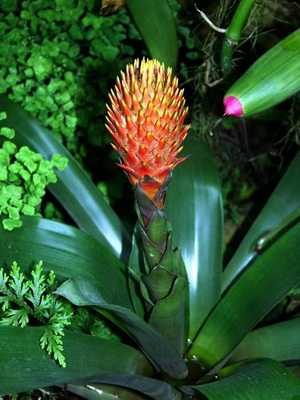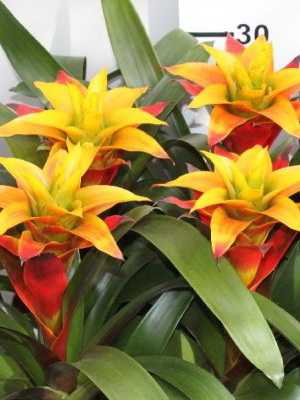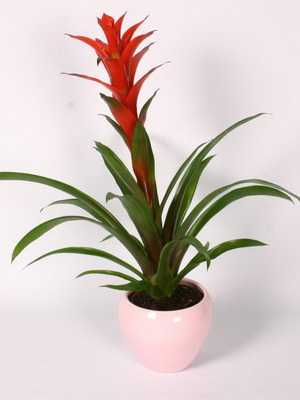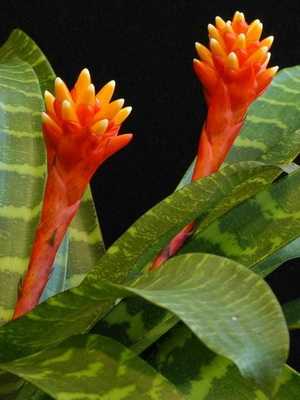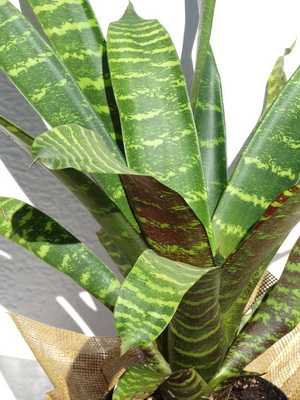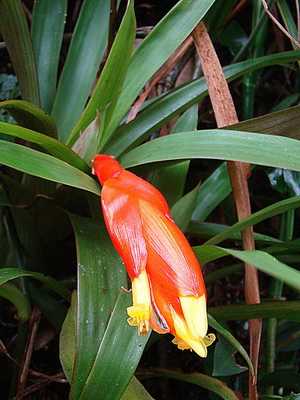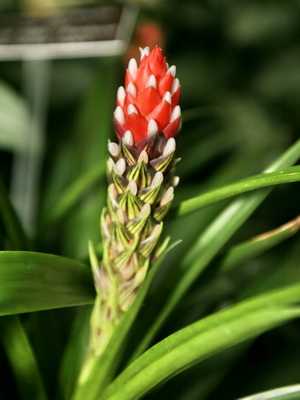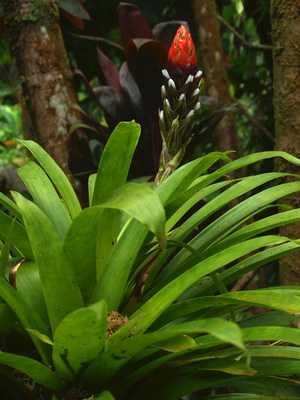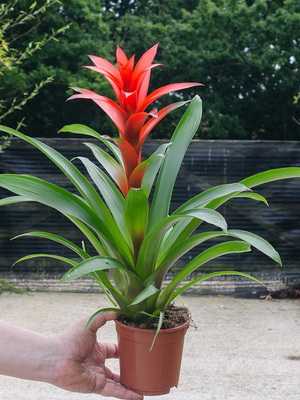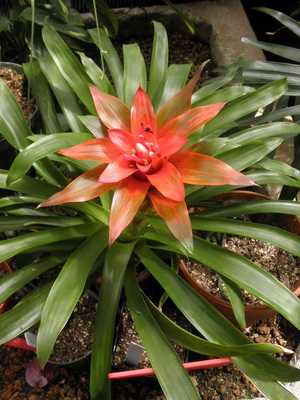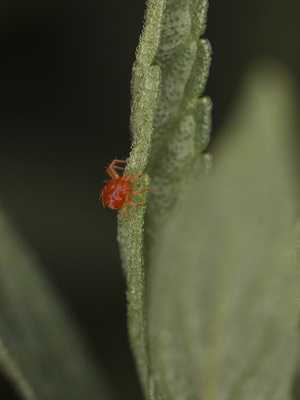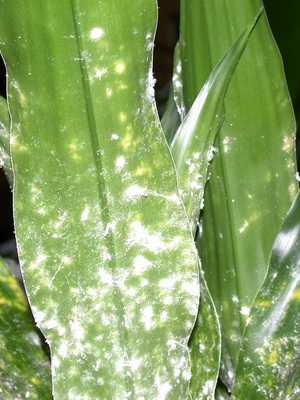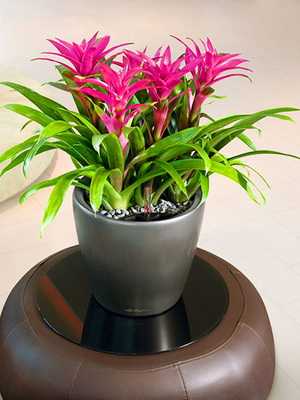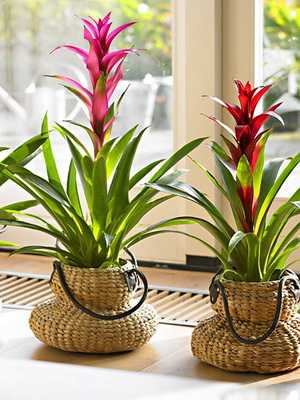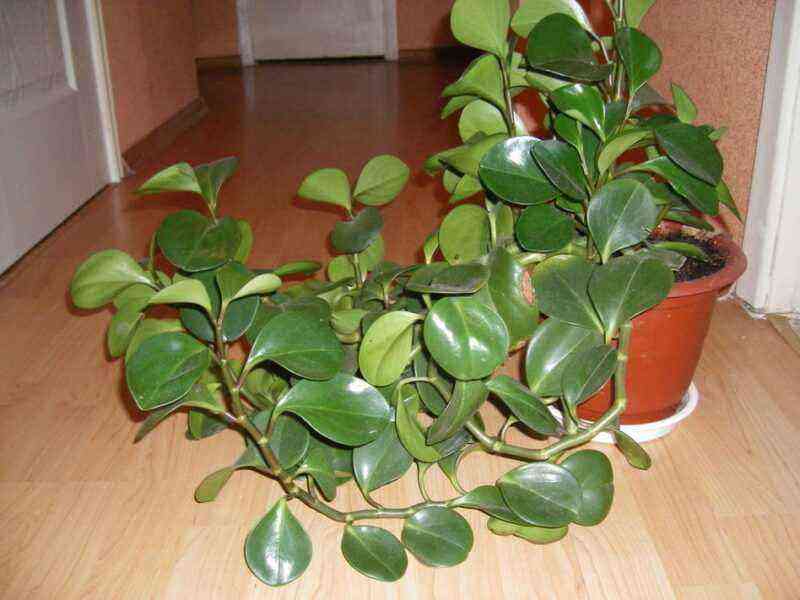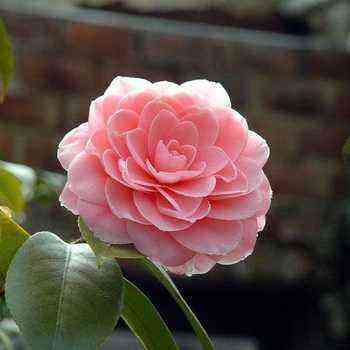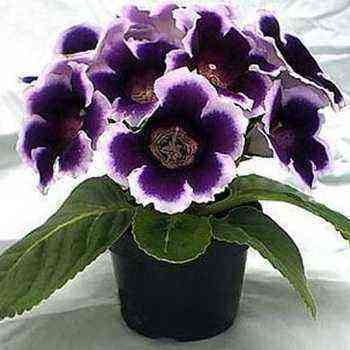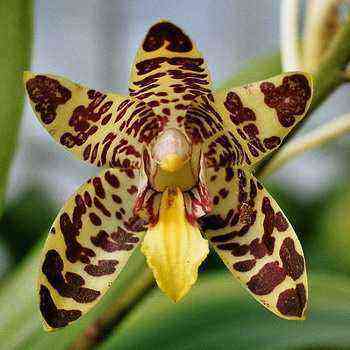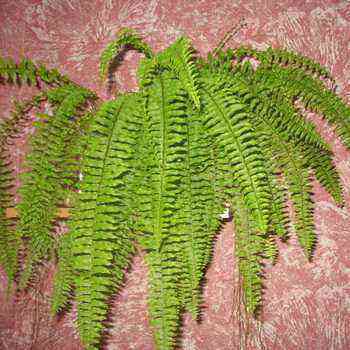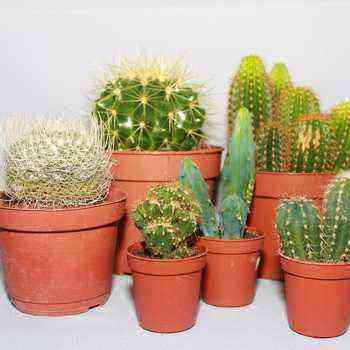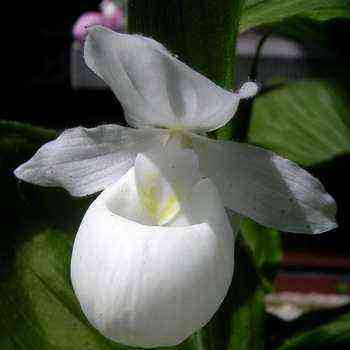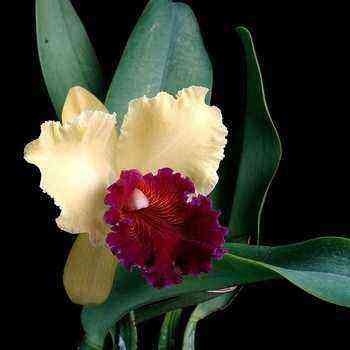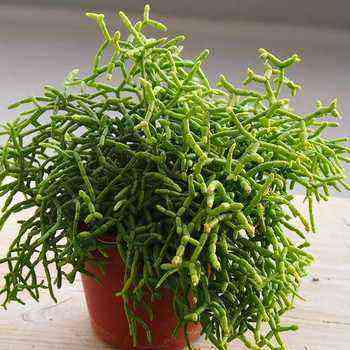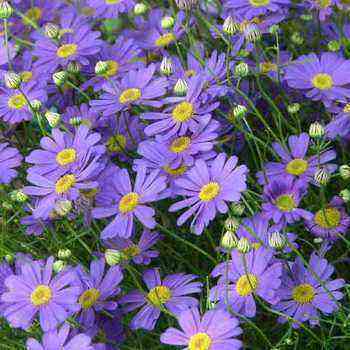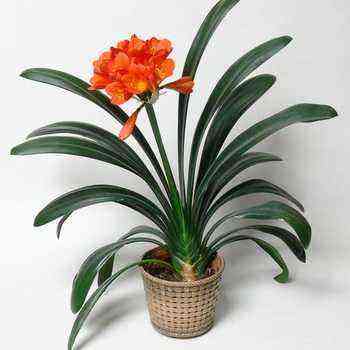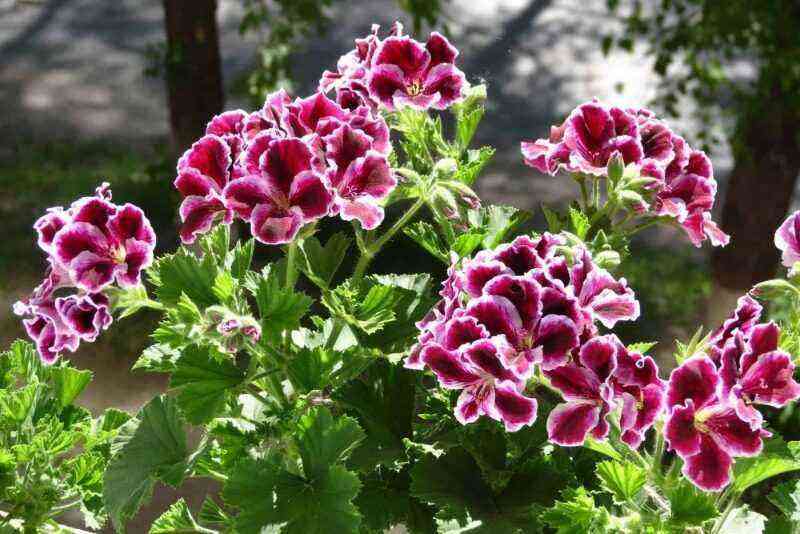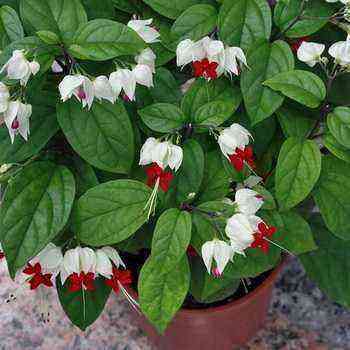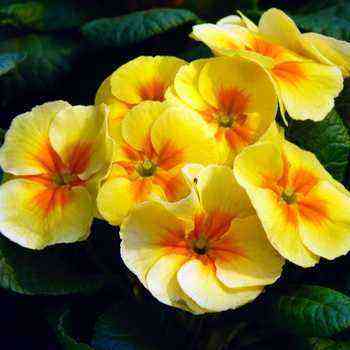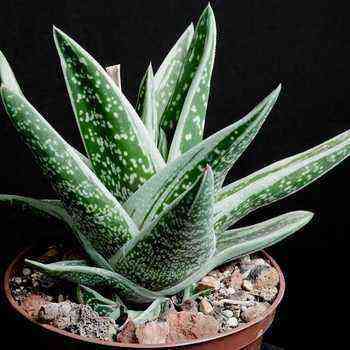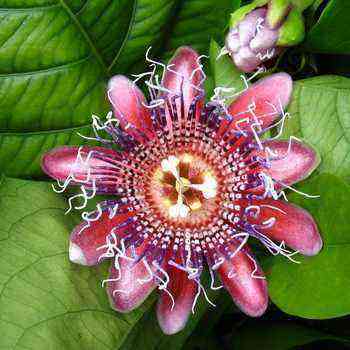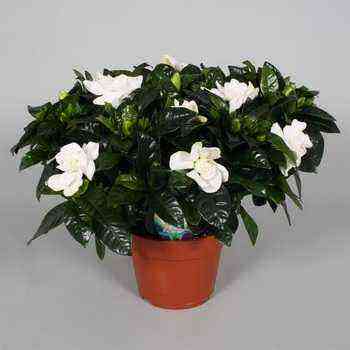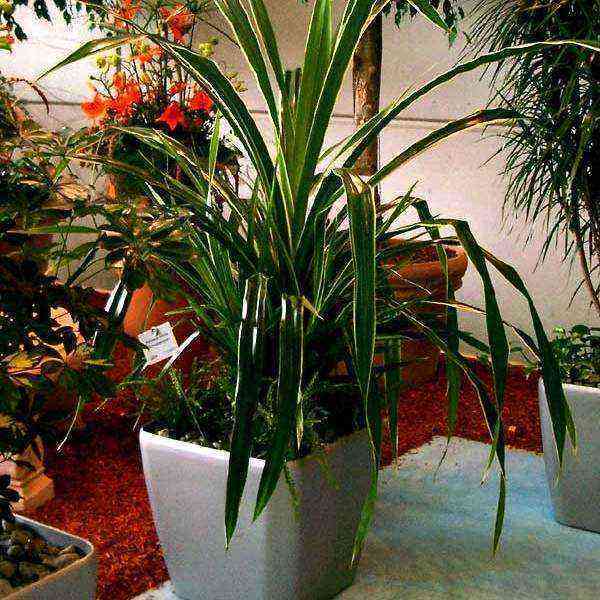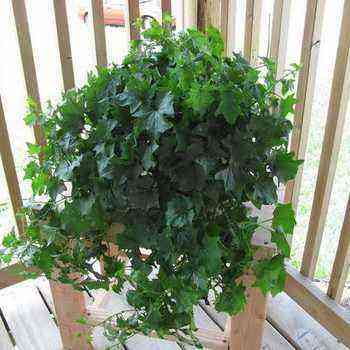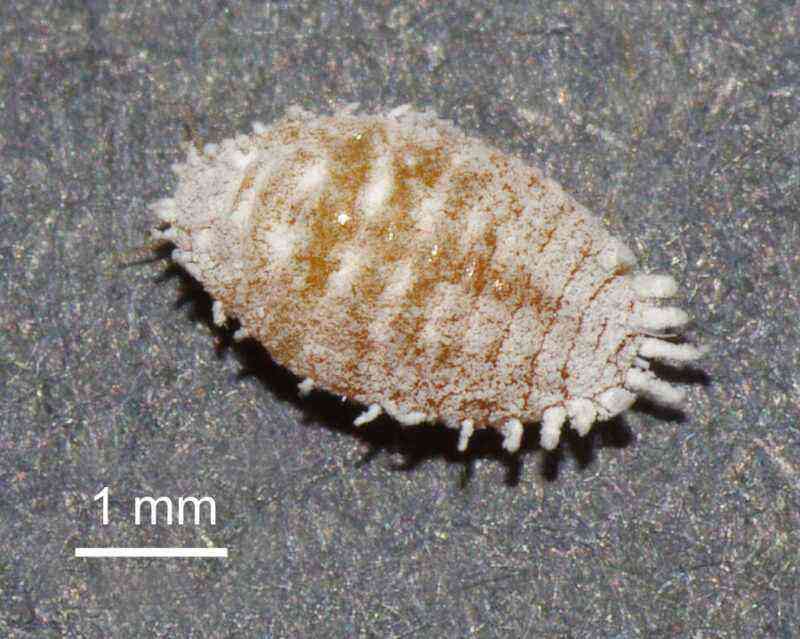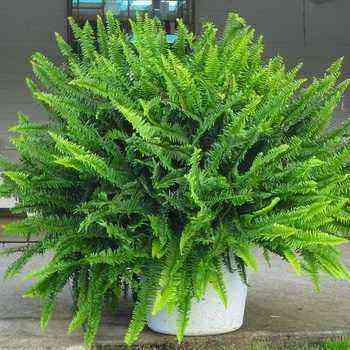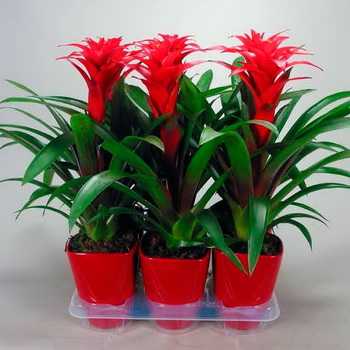
The plant guzmania (Guzmania) belongs to the Bromeliad family. Homeland – South and Central America.
The genus is described in 1802. Named after the Spanish botanist A. Guzman. About 130 species of epiphytes and terrestrial plants are known, common in South Florida, West Indies, Central America, Venezuela, Brazil; grow in forests, on open mountain slopes at an altitude of 2400 m above sea level.
In room culture, more than 50 species of guzmans are known. Used in the device of various compositions, in combination with other plants. Very effective during flowering and individual specimens planted in decorative containers.
What does a guzmania houseplant from the Bromli family look like?
Guzmania from the Bromelivaceae family is a herbaceous stemless, often epiphytic, rosette plant with narrow, smooth, light green shiny leaves.
All indoor plants of guzmania are characterized by small, inexpressive flowers, framed by brightly colored bracts, which serve as the main decoration of the plant. The rosette consists of wide, tongue-shaped, folded back green leaves up to 50 cm in diameter. The inflorescence of guzmania looks like a tall arrow with bright leaves. It is capitate (it may have a cylindrical shape), located on the peduncle, the flowers are white or yellowish, almost sessile, the bracts are broad-lanceolate, red, yellow, orange – depending on the species, they create a semblance of a flower, and the plants owe their popularity to them. When describing guzmania, it is worth noting that the flower retains its decorative effect for several months. Blooms in late autumn or winter.
Types of guzmania and photos of flowering plants
The most popular are:

Guzmania blood red (S. sanguined)
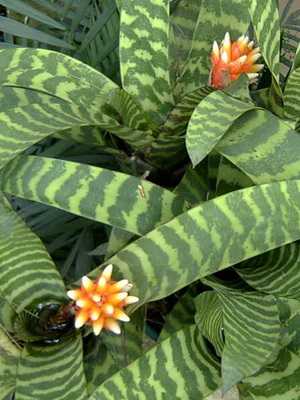
Guzmania mosaic (G. mosaica)
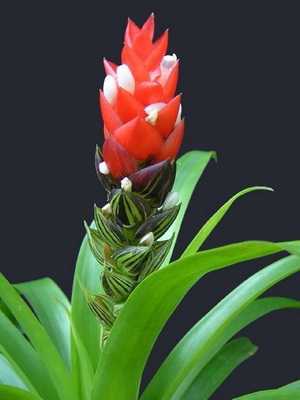
Guzmania one-spiked (G. monostachya)
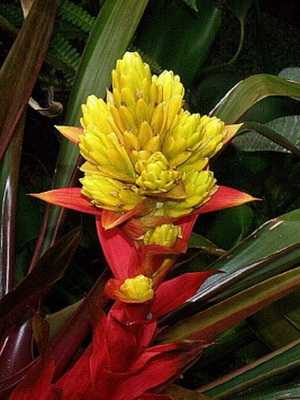
Guzmania Tsana (G. zahnii)
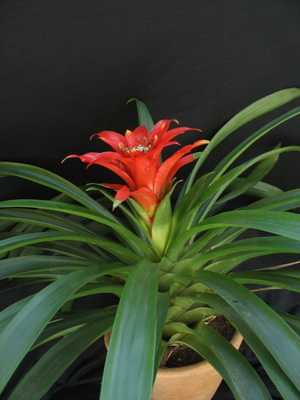
Guzmania reed small (G. lingulata var. Minor)
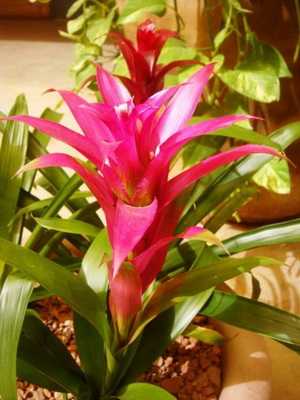
Guzmania Donnell-Smith – Guzmania donnell-smithii, D. Smith
In culture since 1908. Found in Costa Rica, Panama at an altitude of 700-1400 m above sea level, in rain forests. Epiphytic plant. Blooms in April – May.
Look at the photo – the leaves of the guzmania flower are 60 cm long, 3 cm wide, form a loose rosette, tongue-shaped, pointed to the top, green, covered with pale-colored scales:
The peduncle is erect. The leaves on it are tiled, tightly covering the peduncle and the lower part of the inflorescence. The inflorescence is complex, pyramidal-paniculate, short (10 cm), dense, its axis is bare. The lower leaves on the inflorescence are bent, broadly oval, pointed, bright red, with adpressed scales at the top. Spikelets dense, on legs, 2-, 3-flowered, spikelet axis up to 1 cm long. Bracts are rounded, thin-filmy, 8-10 cm long, much shorter than sepals, glabrous. Sepals form a short tube, slightly asymmetric, narrowly elliptical, obtuse, veined, glabrous or with scattered whitish scales. The petals are fused; oval blades, obtuse, up to 2 cm long; the stamens do not protrude from the corolla.

Guzmania blood red – Guzmania sanguinea, Mez.
In culture since 1883. Found in Costa Rica, Colombia, Trinidad and Tobago, Ecuador at an altitude of 1050 m above sea level, in forests. Epiphytic plant. Blooms in April, August.
Leaves, 15-18 in number, form a goblet rosette, reaching up to 30 cm in diameter, broad-linear with the top bent down, whole-edged, during the flowering period all or only the inner ones are bright red.
In the indoor flower of this species, the flower stalk is not developed. Inflorescence of 7-12 flowers, corymbose, with leaf-like envelope, immersed in a socket. Flowers on pedicels. Bracts thin, exceeding sepals. Sepals 1,7 cm long, elliptical, obtuse, fused at the base. Petals 7,5 cm long, broadly oval, grow together into a narrow tube, free at the top.

Known variety short-legged (var. brevipedunculata) – leaves about 20 cm long, 2,5 cm wide; bracts pointed, helmet-shaped, 2,2 cm long, arched-curved, short peduncle.
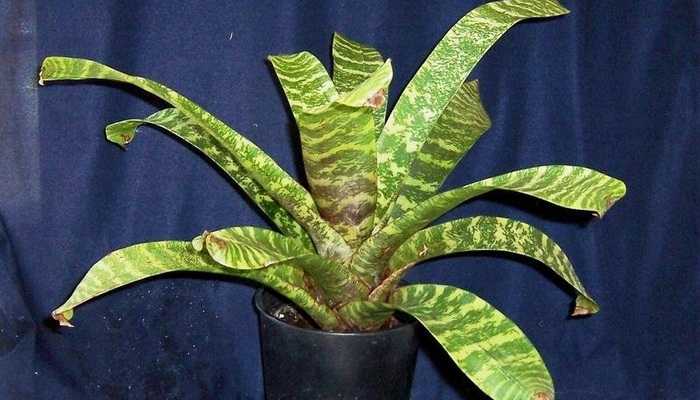
Guzmania mosaic – Guzmania musaica, Mez.
In culture since 1875. Distributed in Panama, Colombia; found in tropical forests; at an altitude of up to 1650 m above sea level. Epiphytic plant. Blooms in July – September.
Pay attention to the photo – in the indoor flower guzmania of this species, the leaves are 70 cm long, 4–8 cm wide, among 15–20 they form a spreading rosette, lingual, rounded at the top, sharply turning into a sharp point, whole-edged:
The peduncle is straight, shorter than the leaves of the rosette, the leaves on the peduncle are broadly elliptic, pointed or with a spike, tiled, swollen, bright pink. The inflorescence is simple, capitate, 12–25 flowers, not pubescent. Bracts are bright pink, wide, obovate, pointed, leathery, half as long as sepals, covering the base of flowers. Sessile flowers; sepals are elongated, obtuse, helmet-shaped, accrete, leathery, yellowish, 2,5–4,5 cm long. Petals are yellowish-white, 3,5 cm long, not protruding during flowering; stamens are shorter than petals.
There are known varieties of mosaic guzmania:
- var. concolor (one color) – leaves are one color;
- var. zebrina (zebra) – leaves with wide stripes.
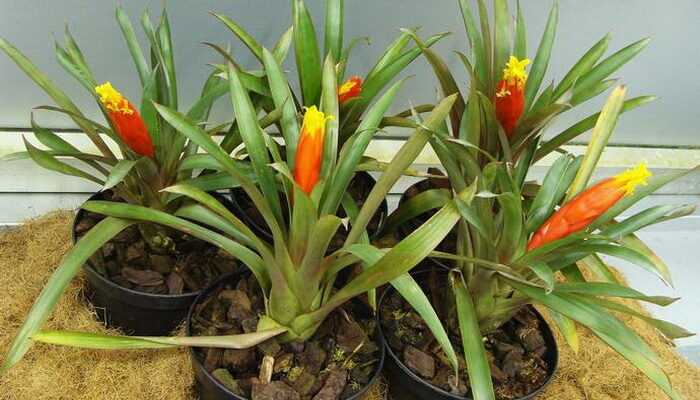
Guzmania Nicaraguan – Guzmania nicaraguensis, Mez.
In culture since 1903. Found in Mexico, Central America at an altitude of 635-1800 m above sea level, in the forests. Epiphytic plant. Blooms in March – May.
Leaves up to 6 cm long, 2,5 cm wide, including 10-15, form a dense goblet rosette with an inflorescence immersed in it, lingual, narrowed to the apex, with a pointed tip, covered with small pale-colored, appressed scales below, become bare over time, with noticeable small longitudinal red streaks.
As you can see in the photo, the peduncle of this species is not pubescent in the domestic guzmania flower:
The leaves on the peduncle are erect, appressed, the lower ones are narrowly linear, the upper ones are broadly elliptic, with a pointed tip, bright red or red-brown. The inflorescence is simple, few-flowered, fusiform in outline, glabrous, 7-10 cm long. The bracts are similar in shape to the upper leaves of the peduncle, thin-filmy, obtuse or broadly pointed, without peaks, 5 cm long. Flowers on short legs, erect; sepals are elliptical, broadly-pointed, thin-filmy, fused at the bottom, 2,5 cm long. Petals are yellow, grow together into a narrow-cylindrical tube, free at the top. The stamens barely protrude above the corolla. The fruit is a capsule.
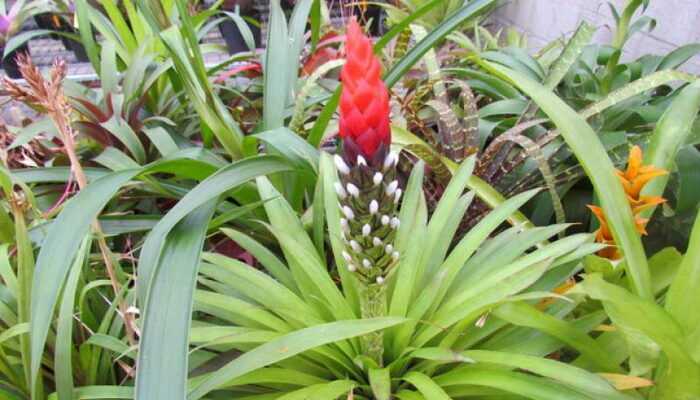
Guzmania one-headed – Guzmania monostachia, Mez.
In culture since 1896. Distributed from South Florida, West Indies, Nicaragua to Northern Brazil and Peru; at an altitude of up to 2000 m above sea level, in the forests. Epiphytic or terrestrial plant. Blooms in June, July.
Numerous leaves, 5-40 cm long, 2 cm wide, form a dense rosette, narrow-linear, pointed, yellow-green, paler below, with indistinct small-dotted scales, which soon fall off.
Look at the photo – the blooming guzmania has an inflorescence in the form of a simple, elongated, multi-row cylindrical spike, pointed at the top, 8-15 cm long, 2-3 cm in diameter:
The axis of the inflorescence is straight, naked. Peduncle is straight, shorter than leaves, glabrous. The leaves on it are oval, pointed, tiled; the lower ones are pale green, the upper ones with red strokes. Bracts are oval, pointed, thin-filmy, tiled; in fertile flowers, pale-colored, with noticeable brown longitudinal strokes; sterile ones are bright red, less often white. Flowers are erect, white, 2,3–2,9 cm long. Sepals are 1,8 cm long, obovate, wide, obtuse, smooth, leathery, partially fused. The petals are fused, the lobes of the corolla are elliptical, obtuse; the stamens do not protrude from the corolla.
The fruit is a cylindrical box with a white tuft, 2-3 cm long.
Varieties of single-spiked guzmania:
- white (var. alba) – leaves are one-color, lower bracts are green, upper (in sterile flowers) – white;
- variegated (var. variegata) – green leaves with white strokes; the fruit is a box.

Guzmania reed – Guzmania lingulata, Mez.
In culture since 1896. Distributed in Honduras, West Indies, Bolivia, Ecuador; in tropical and subtropical forests; at an altitude of up to 1100 m above sea level. Epiphytic or epilithic plant. Blooms in March, August, December.
Numerous (15–30) leaves 30–45 cm long, 4 cm wide, in a flat rosette, broadly linear, pointed, entire, with small dotted scales.
As shown in the photo, in the guzmania of this species, the peduncle is straight, thick, shorter than the leaves:
The leaves on it are erect, tiled, the lower ones are rosettes similar to leaves, the upper ones are lanceolate, bright red, form a wrapper around the inflorescence. The inflorescence is simple, corymbose, multi-flowered, up to 7 cm in diameter. Bracts are linear, helmet-shaped, shorter than flowers. Flowers on short, thick legs with linear free sepals and white helmet-shaped petals. The stamens are largely fused with the petals.
Varieties:
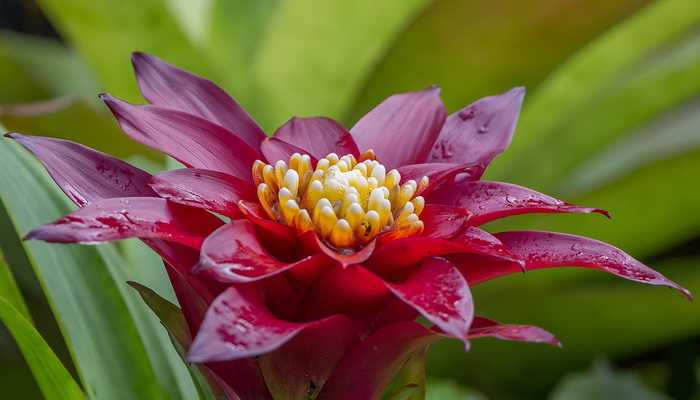
purple (var.cardinalis) – leaves 3-4 cm wide, multi-flowered inflorescence, sprawling inflorescence leaves, bright red, helmet bracts. Grows in Colombia, Ecuador, occurs at an altitude of 1000 m above sea level, in forests. Blooms in March, September

sad (var. minor) – a small plant, leaves no more than 2,5 cm wide, one-color. The inflorescences are erect, red. Bracts are slightly helmet-shaped. The flowers are numerous. Occurs from Guatemala to Colombia and North-East Brazil at an altitude of 70-1000 m above sea level, in forests
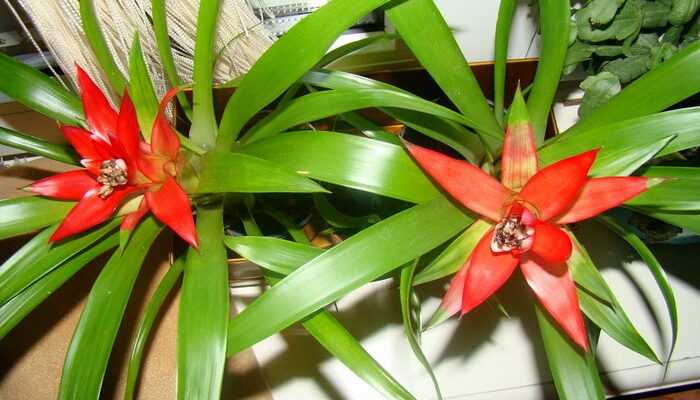
fiery (var. flammea) – Leaves 24–34 cm long, 1–1,7 cm wide. Inflorescence has few flowers. Bracts are slightly helmet-shaped. Found in Colombia, Ecuador at an altitude of 5-1000 m above sea level. Blooms in July and August.
Next, you will learn how to care for guzmania at home.
How to care for homemade guzmania in a pot
Accommodation.Guzmania needs diffused light all year round. Guzmania is a thermophilic plant that does not tolerate direct sunlight. To care for the guzmania as carefully as possible, it should be placed on the windows facing the west side. Often used to compose landscape compositions.
Temperature.During flowering, the temperature of the content should be elevated, the rest of the time – not lower than 16-18 ° C.
Humidity.The plant is hygrophilous. When caring for a flower at home, a guzmania needs not only high air humidity – at least 70%, but also good circulation (ventilation without drafts). To care for guzmania in a pot, as experienced flower growers advise, to increase the humidity, you need to put the plant on a pallet with wet pebbles.
The main pests are spider mites, mealybugs and scale insects. With improper care of room guzmania (lack or excess of moisture), the plant turns brown and leaves fall off.
Fungal diseases caused by high humidity and ambient temperature are possible. With excessive watering, the roots can rot, in this case, you should reduce watering and pour water into a leaf outlet.
Breeding. Offshoots that form at the base of the plant. Perhaps with seeds at a temperature of 22-25 ° C, the seeds are not covered with soil, they germinate in the light.
Room guzmania care: watering and feeding
To water this plant, it is imperative to use soft, settled water at room temperature. Guzmania loves moisture, so watering should be abundant, especially in spring and summer. In this case, you need to pour water into the middle of the leaf outlet. In the warm season, guzmania needs frequent spraying. In winter, watering is moderate, without spraying. Watering with soft, lime-free water. Good drainage is essential.
In the process of caring for a guzmania flower, the plant needs to be fed with liquid fertilizers for bromeliads twice a month, in winter – once every two months.
The transplant is not carried out, since after flowering the plant dies off.
Grown in baskets and pots (10-12 cm in diameter), in a mixture of crushed fern and sphagnum roots (1: 1), or in a substrate of high fiber peat and charcoal (1: 1), with the addition of soddy clay soil and sand … The substrate is perfect – fibrous peat, sod and leafy soil, sand (2: 1: 1: 0,5).
You can also use a mixture of crushed pine bark, sphagnum moss, high peat, vermiculite (in equal proportions), with the addition of pieces of charcoal. When planting, it is necessary to put a drainage layer in pots or baskets (1 / 3-1 / 2 of the height of the container).
